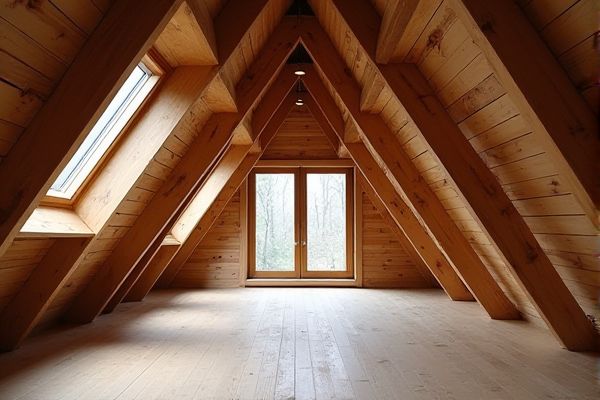
Wooden beams in attics offer natural insulation and aesthetic warmth while being cost-effective and easier to install, whereas steel beams provide superior strength, durability, and resistance to pests and fire. Discover more about choosing between attic wooden beams and steel beams to ensure your space meets your structural and design needs.
Table of Comparison
| Feature | Attic Wooden Beams | Steel Beams |
|---|---|---|
| Material | Natural wood (often oak, pine) | Steel (various grades, e.g., A36) |
| Strength | Moderate, suitable for light to medium loads | High, supports heavy loads and long spans |
| Durability | Susceptible to rot, pests, and moisture damage | Resistant to rot, pests, and moisture with proper coating |
| Maintenance | Requires regular inspection and treatment | Low maintenance with protective coatings |
| Installation | Relatively easy, lighter weight | Requires heavy equipment and skilled labor |
| Cost | Lower initial cost, variable by wood type | Higher initial cost, but longer lifespan |
| Fire Resistance | Low, wood is combustible | High, non-combustible steel |
| Environmental Impact | Renewable resource, biodegradable | Energy-intensive production, recyclable |
| Appearance | Natural, traditional aesthetic | Modern, industrial look (can be concealed) |
Introduction to Attic Structural Beams
Attic structural beams are crucial for supporting roof loads and maintaining the integrity of upper floors, with wooden beams and steel beams being the most common materials used. Wooden beams, often crafted from solid timber or engineered wood like laminated veneer lumber (LVL), offer natural insulation and aesthetic appeal but may require treatment for pests and moisture resistance. Steel beams provide superior strength-to-weight ratios and greater load-bearing capacity, making them ideal for larger spans or heavy roofing materials, though they typically involve higher costs and require corrosion protection.
Overview of Wooden Beams
Wooden beams, commonly crafted from species like Douglas fir, pine, or oak, provide natural aesthetic appeal and excellent insulation properties in attics. Engineered wood beams such as LVL (Laminated Veneer Lumber) offer enhanced strength and dimensional stability compared to traditional solid wood. These beams support typical attic loads efficiently but may require treatment to resist pests, moisture, and fire hazards.
Overview of Steel Beams
Steel beams offer superior strength and durability compared to wooden beams in attic construction, providing enhanced support for heavy loads and long spans. They resist warping, insect damage, and fire, resulting in lower maintenance and increased safety for your attic structure. Choosing steel beams can optimize space utilization and long-term stability in roofing and floor framing projects.
Strength and Load-Bearing Capacity
Wooden beams in attics typically offer adequate strength for moderate loads but may suffer from limitations such as susceptibility to warping and decay over time. Steel beams provide superior load-bearing capacity with high tensile strength, making them ideal for supporting heavy structural loads and longer spans without deflection. The choice between wooden and steel beams depends on the specific load requirements, span length, and environmental conditions within the attic space.
Durability and Lifespan Comparison
Wooden attic beams typically offer a natural aesthetic but are prone to deterioration from moisture, insects, and rot, resulting in a lifespan averaging 50 to 80 years with proper maintenance. Steel beams provide superior durability, resisting warping, pests, and fire, often lasting 75 to 100 years or more with minimal upkeep. The enhanced strength and resistance of steel beams make them a preferred choice for long-term structural integrity in attic construction.
Resistance to Pests and Moisture
Wooden attic beams are vulnerable to termite infestations and mold growth when exposed to moisture, compromising structural integrity over time. Steel beams offer superior resistance to pests and are impervious to moisture-induced decay, enhancing durability in humid or pest-prone environments. Proper treatment and maintenance can mitigate wood vulnerabilities, but steel remains the optimal choice for long-term resistance.
Cost and Budget Considerations
Wooden attic beams generally cost less upfront than steel beams, making them a popular choice for budget-conscious homeowners. Steel beams, while more expensive initially, offer greater strength and durability, potentially reducing long-term maintenance costs. Your decision should weigh the initial budget against future savings and structural needs to optimize value.
Installation and Maintenance Needs
Wooden attic beams are easier to install using basic carpentry tools, but they require regular maintenance to prevent issues like rot, insect damage, and warping. Steel beams demand specialized equipment and professional installation due to their weight and handling requirements, yet they offer superior durability with minimal upkeep over time. Choosing the right material for your attic beams depends on balancing installation complexity with your long-term maintenance preferences.
Environmental Impact and Sustainability
Wooden attic beams offer a renewable and biodegradable option that significantly reduces carbon footprint through carbon sequestration during tree growth. Steel beams involve higher embodied energy and resource-intensive manufacturing processes but provide longevity and recyclability, potentially offsetting initial environmental costs. You should evaluate your project's sustainability goals to determine whether natural wood's eco-friendliness or steel's durability aligns better with your environmental impact priorities.
Choosing the Right Beam for Your Attic
Selecting between attic wooden beams and steel beams depends on factors such as load-bearing capacity, budget, and aesthetic preferences. Wooden beams offer natural insulation and a traditional look but may require more maintenance and are susceptible to pests and moisture. Steel beams provide superior strength, durability, and resistance to environmental damage, making them ideal for larger spans and modern designs.
 homyna.com
homyna.com